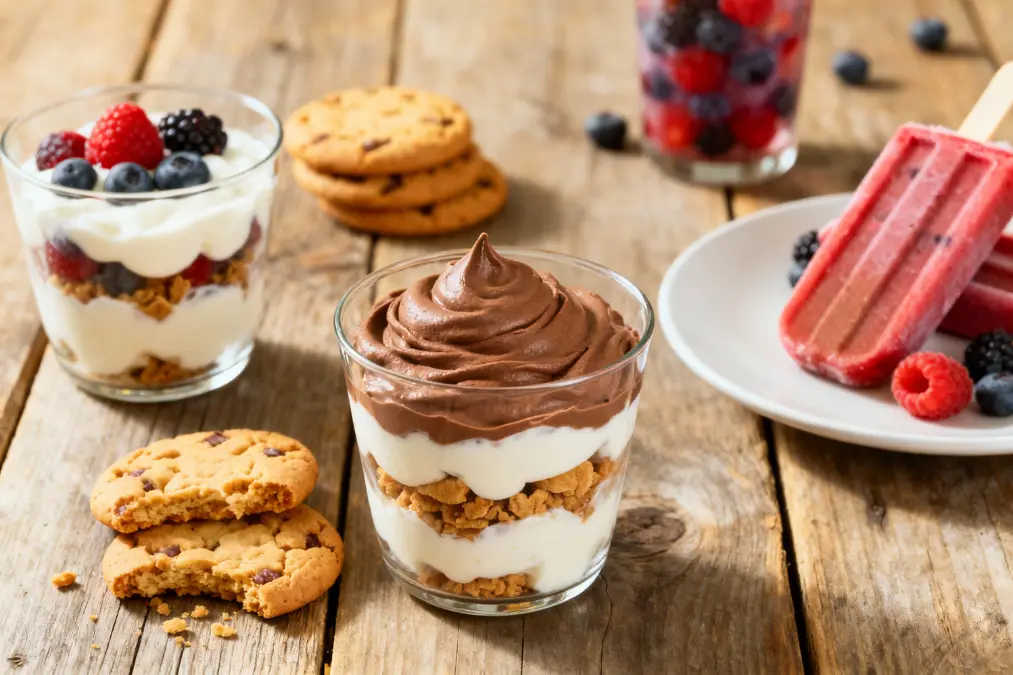Crave high protein desserts that taste like the real thing, not a compromise? These high protein recipes deliver creamy, fudgy bites with real fuel, quick prep, and zero chalky vibes.
Table of Contents
Discover high protein desserts that taste indulgent, not chalky. These quick recipes mix flavor and fuel, showing how protein can make your treats satisfying and smart. From Greek yogurt mousse to cottage cheese brownies, each bite proves healthy can still taste incredible.
Listen to the High-Protein Dessert Podcast
Get quick, simple insights from Mia and Chef Brooke on how protein transforms your desserts into smarter, more satisfying treats. Press play to learn the easiest upgrades you can use today.
Protein 101 for Desserts
Why high protein desserts help
High protein desserts support fullness, steadier energy, and post workout recovery when they replace low protein sweets. Protein is the most satiating macronutrient, and pairing a sweet treat with meaningful protein helps curb cravings while supporting muscle repair after training. Keep portions reasonable and favor simple, real ingredients so the win is both taste and nutrition.
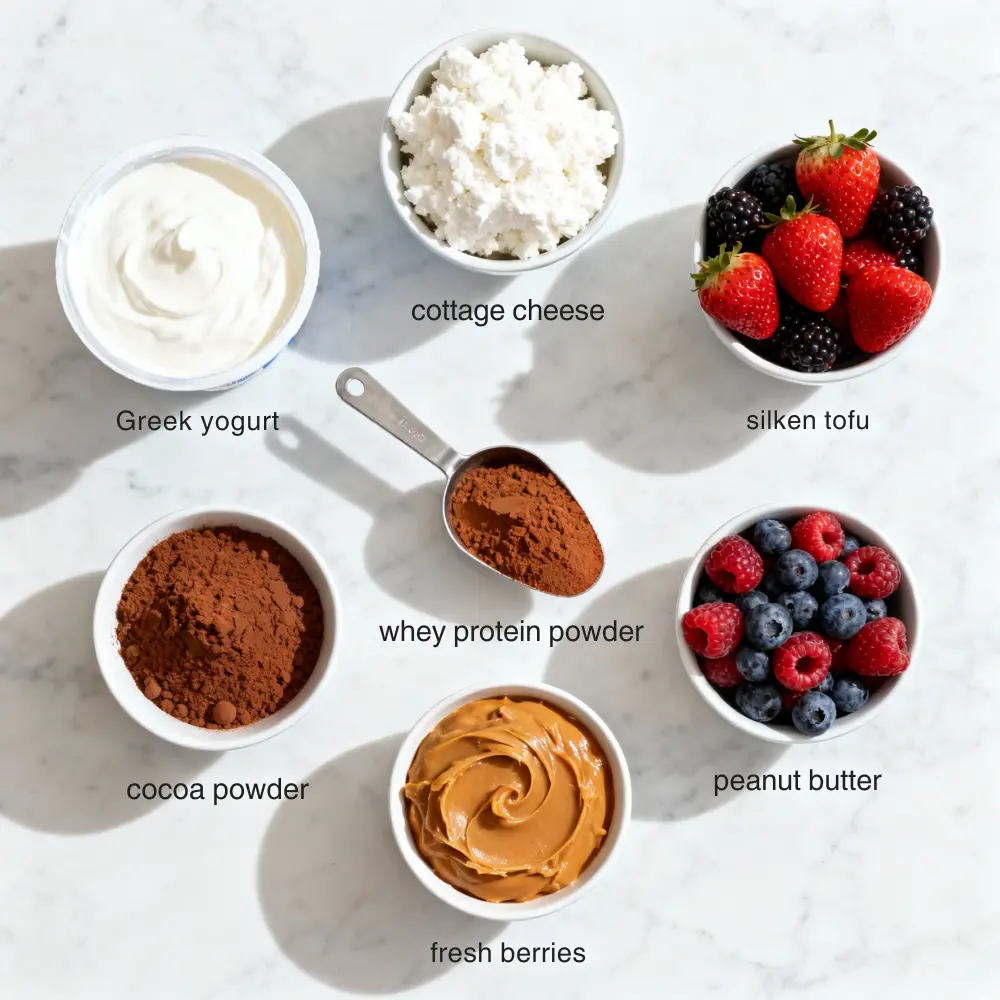
Best protein sources for sweet recipes
For high protein desserts and high protein recipes, pick bases that blend smooth and taste clean. Whey mixes easily and has a strong essential amino acid profile. Plant options like pea, soy, and hemp work well but may need a little extra liquid and flavor boosters like cocoa or vanilla. Whole food choices keep flavors natural and textures creamy, including Greek yogurt, cottage cheese, silken tofu, beans, skyr, and ricotta.
Quick protein table by ingredient
Values are typical averages. Check your product label for exact numbers.
| Ingredient | Typical serving | Protein g | Texture notes | Allergen flags |
|---|---|---|---|---|
| Greek yogurt, nonfat | 170 g cup | ~17 | Thick and tangy, blends creamy | Dairy |
| Cottage cheese | 113 g, about 1/2 c | ~12 | Curdy to creamy, whips very smooth | Dairy |
| Skyr, plain | 170 g cup | ~15 to 17 | Extra thick, mild flavor | Dairy |
| Ricotta, part skim | 1/2 cup | ~14 | Light, slightly grainy, great in mousse | Dairy |
| Silken tofu | 100 g | ~5 | Ultra smooth, takes cocoa well | Soy |
| Cooked black beans | 1/2 cup | ~7 to 8 | Adds body to brownies | Legume |
| Peanut butter | 2 tbsp | ~7 to 8 | Rich, binds no bake doughs | Peanut |
| Whey protein powder | 30 g scoop | ~20 to 25 | Smooth if hydrated well | Dairy |
How to Build Great High Protein Desserts
Key ingredients and smart substitutions
Creating high protein desserts that taste smooth and rich starts with balanced ingredients. Sweeteners like honey, monk fruit, or stevia keep calories low while enhancing flavor. Binders such as eggs, chia seeds, or flaxseed help maintain structure. To keep moisture and creaminess, use Greek yogurt, mashed banana, or a splash of almond milk. For flavor depth, add cocoa, vanilla, or a small pinch of salt. A simple rule of thumb is one part protein powder to three parts liquid for creamy, spoonable texture. You can find more smart substitution tips in this healthy baking guide to improve both texture and nutrition in your protein treats.
Fix chalky or dense textures
If your high protein desserts feel gritty or too heavy, rest the batter for ten minutes to hydrate powders. Blend longer for a smoother consistency, and balance with a bit more liquid or yogurt. A tiny pinch of salt enhances sweetness naturally. Serve chilled rather than overbaked or overheated, and choose neutral powders or whole food bases for a cleaner taste. These adjustments keep high protein recipes creamy and satisfying.
When to eat them
High protein desserts fit anywhere in your day. Enjoy one after a workout to help muscle recovery, as a late morning snack to curb hunger, or after dinner when you want something sweet but steady. Keep portions between one and two servings depending on your activity level.
Storage, meal prep, and cost per serving
Batch high protein desserts a few at a time to save time. Most keep well for three to five days refrigerated or up to one month frozen. Thaw gently overnight for best texture. Homemade high protein recipes often cost about half of store options, giving you flavor, nutrition, and savings in every serving.
Recipes Without Protein Powder
Chocolate Cottage Cheese Pudding

Macros per serving
Approx 220 kcal, 22 g protein, 16 g carbs, 7 g fat
Makes 4 servings
Ingredients
- 2 cups cottage cheese
- 3 tbsp unsweetened cocoa powder
- 3 to 4 tbsp maple syrup or honey, to taste
- 2 to 4 tbsp milk of choice, as needed
- 1 tsp vanilla extract
- Pinch of fine salt
- Optional toppings: sliced berries, shaved dark chocolate
Directions
- Blend cottage cheese until completely smooth.
- Add cocoa, sweetener, vanilla, and salt. Blend again.
- Add milk a little at a time until creamy and spoonable.
- Chill 30 to 60 minutes for best texture. Serve with berries.
Substitutions
- For lighter carbs, use monk fruit or stevia and add an extra tablespoon of milk.
- Swap half the cottage cheese for Greek yogurt for a tangier finish.
- Add 1 tbsp peanut butter for richer flavor and a touch more protein.
Storage
Refrigerate in covered cups for up to 3 days. Do not freeze.
Black Bean Espresso Brownies

Macros per brownie
Approx 180 kcal, 7 g protein, 24 g carbs, 6 g fat
Makes 12 brownies
Ingredients
- 1 can black beans, drained and rinsed well
- 2 large eggs, or 2 flax eggs
- 1⁄3 cup unsweetened cocoa powder
- 1⁄2 cup sugar or 1⁄3 cup maple syrup
- 2 tbsp neutral oil
- 1 tsp vanilla extract
- 1 to 2 tsp instant espresso powder
- 1 tsp baking powder
- Pinch of salt
- Optional add-ins: 1⁄4 cup chopped nuts or dark chocolate pieces
Directions
- Heat oven to 350°F, line an 8 inch pan with parchment.
- Blend beans and eggs until silky.
- Add cocoa, sweetener, oil, vanilla, espresso, baking powder, and salt. Blend smooth.
- Fold in any add-ins. Spread in pan.
- Bake 18 to 22 minutes until the center is just set. Cool fully for clean slices.
Substitutions
- Use oat flour, 2 to 3 tbsp, if you want a cakier crumb.
- Replace oil with 3 tbsp Greek yogurt for a lighter fat profile.
- Skip espresso and add 1 tsp cinnamon for a mocha free option.
Storage
Keep covered at room temp 1 day, then refrigerate up to 4 days. Freeze up to 1 month. Thaw in the fridge.
Greek Yogurt Berry Popsicles

Macros per pop
Approx 110 kcal, 9 g protein, 15 g carbs, 2 g fat
Makes 8 pops
Ingredients
- 2 cups Greek yogurt, plain
- 1 cup berry puree or chopped mixed berries
- 3 to 4 tbsp honey or maple syrup, to taste
- 1 tsp vanilla extract
- 1 to 2 tbsp lemon juice, optional
Directions
- Stir yogurt with sweetener, vanilla, and lemon juice.
- Swirl in berries to create ribbons or mix fully for a uniform color.
- Pour into molds, insert sticks, and freeze 4 to 6 hours.
Substitutions
- For extra creaminess, fold in 2 tbsp cottage cheese before freezing.
- For lower sugar, reduce sweetener and add a pinch of salt to boost perceived sweetness.
- Swap berries for diced mango or peaches when in season.
Storage
Keep frozen up to 6 weeks. Run molds under warm water a few seconds to release.
These three high protein desserts show that high protein recipes can be creamy, kid friendly, and budget smart, while adding real value with practical prep, clear portions, and simple swaps.
Recipes With Protein Powder
High Protein Chocolate Mousse
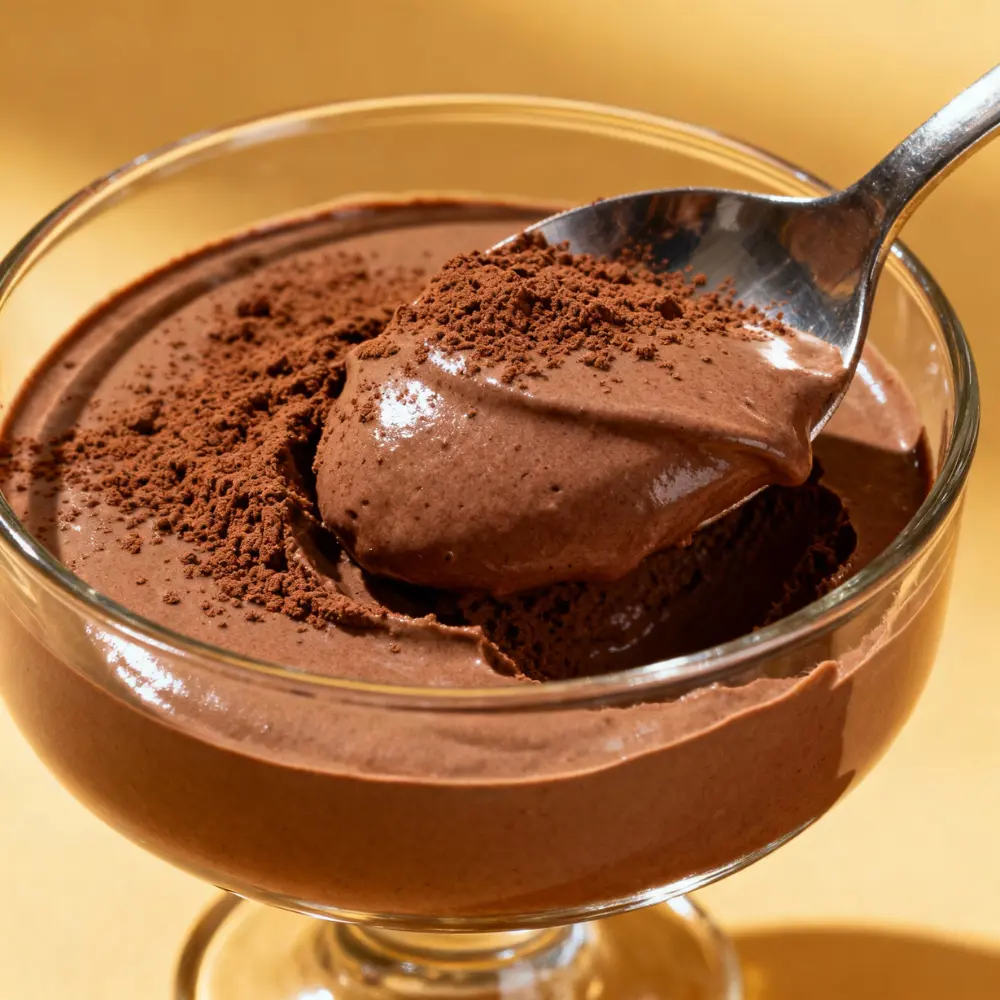
Macros per serving
Approx 210 kcal, 24 g protein, 18 g carbs, 5 g fat
Makes 4 servings
Ingredients
- 1 cup Greek yogurt, plain
- 1 cup cottage cheese
- 2 scoops chocolate protein powder
- 2 tbsp unsweetened cocoa powder
- 2 to 4 tbsp milk of choice, as needed
- 1 to 3 tbsp honey or monk fruit, to taste
- 1 tsp vanilla extract
- Pinch of fine salt
Directions
- Blend yogurt and cottage cheese until completely smooth.
- Add protein powder, cocoa, sweetener, vanilla, and salt. Blend again.
- Add milk a little at a time until mousse like.
- Chill 60 minutes for the best texture.
Substitutions
- For a lighter texture, swap half the cottage cheese for extra yogurt.
- For deeper chocolate, add 1 tsp espresso powder.
- For dairy free, use a thick plant yogurt and a plant protein powder.
Storage
Refrigerate up to 3 days. Do not freeze.
Protein Packed Peanut Butter Cookies
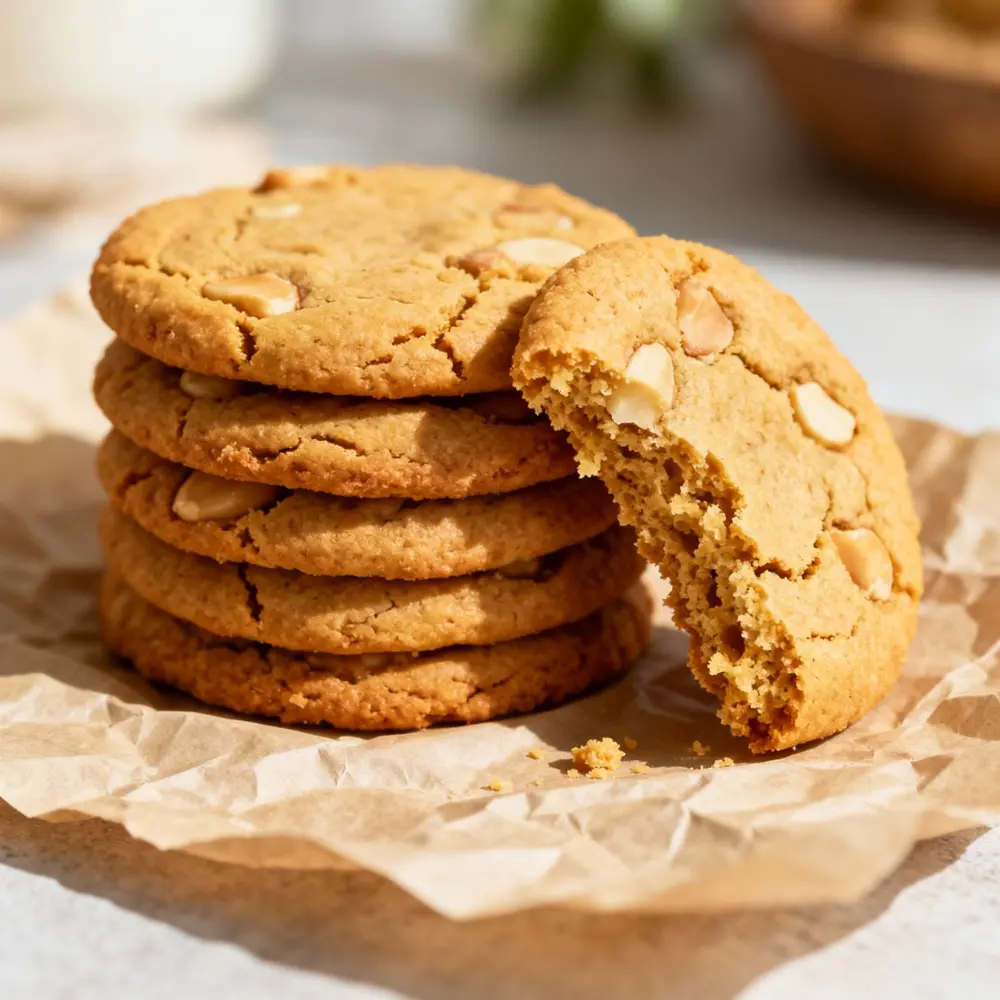
Macros per cookie
Approx 150 kcal, 8 g protein, 12 g carbs, 8 g fat
Makes 16 cookies
Ingredients
- 3⁄4 cup natural peanut butter
- 1⁄2 cup vanilla or unflavored protein powder
- 1⁄3 cup coconut sugar or 1⁄4 cup maple syrup
- 1 large egg or 1 flax egg
- 1⁄4 tsp baking powder
- Pinch of salt
- 1 to 2 tbsp milk of choice if needed
Directions
- Heat oven to 350°F. Line a baking sheet.
- Stir peanut butter, protein powder, sugar, egg, baking powder, and salt.
- If the dough is dry, add milk 1 tbsp at a time.
- Scoop, place on the sheet, press gently with a fork.
- Bake 8 to 10 minutes until edges set. Cool on the sheet.
Substitutions
- Swap peanut butter for almond butter.
- For a softer bite, add 1 tbsp yogurt to the dough.
- For chocolate chips, fold in 2 tbsp mini chips.
Storage
Keep in an airtight box at room temp 2 days, then refrigerate up to 5 days. Freeze up to 1 month.
Banana Protein Ice Cream

Macros per serving
Approx 170 kcal, 16 g protein, 24 g carbs, 2 g fat
Makes 4 servings
Ingredients
- 3 ripe bananas, sliced and frozen
- 1 scoop vanilla protein powder
- 1⁄3 cup milk of choice
- 1 tsp vanilla extract
- Pinch of salt
- Optional add ins: 1 tbsp cocoa powder, 1 tbsp peanut butter, cinnamon
Directions
- Add frozen banana slices to a blender.
- Add protein powder, milk, vanilla, and salt.
- Blend until thick and creamy, scraping the sides as needed.
- Serve soft or freeze 2 to 3 hours for a firmer scoop.
Substitutions
- For extra protein, add 2 tbsp cottage cheese before blending.
- For a strawberry version, swap half the banana for frozen berries.
- For lower sugar, use greener bananas and add cinnamon.
Storage
Freeze in a covered container up to 2 weeks. Let sit 5 to 10 minutes at room temp before scooping.
These high protein desserts show how high protein recipes can be quick, creamy, and budget friendly while adding real value with clear macros, easy steps, and smart substitutions.
Global Twists and Dietary Variants
Vegan Silken Tofu Chocolate Pots
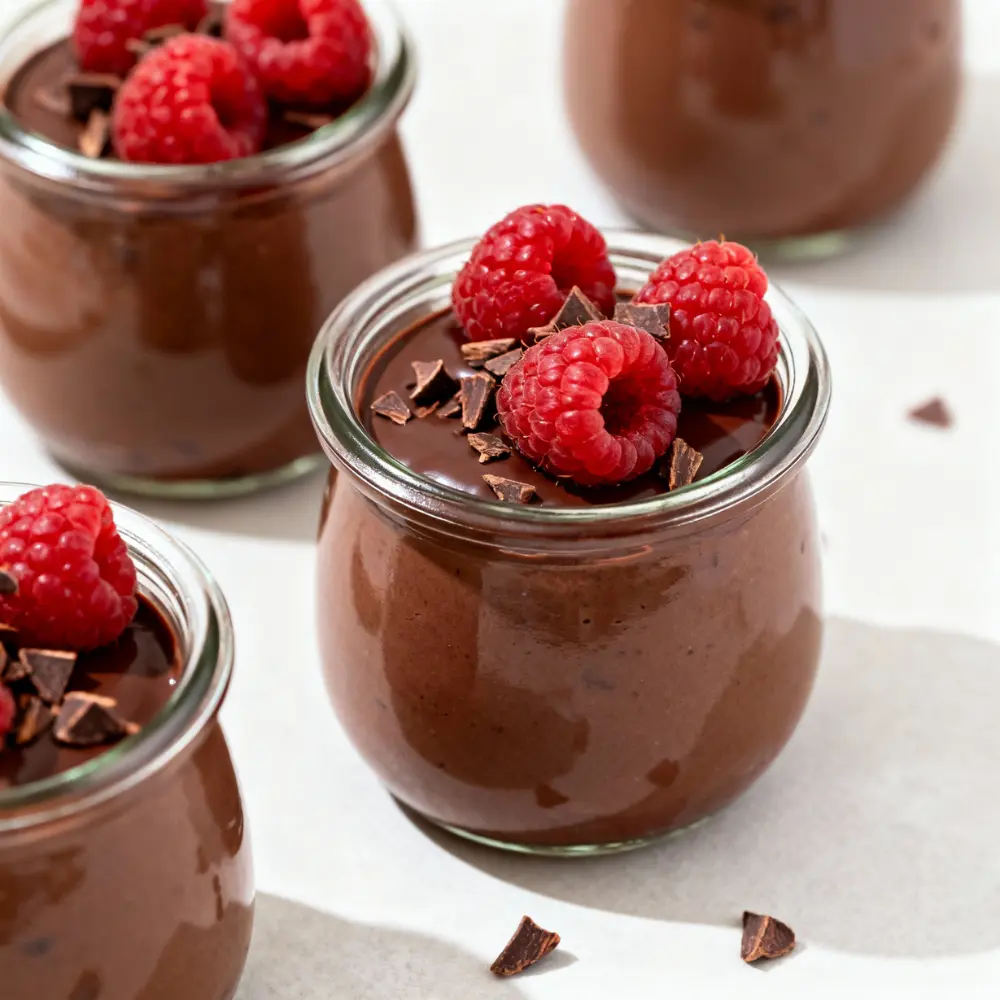
Macros per serving
Approx 190 kcal, 9 g protein, 20 g carbs, 8 g fat
Makes 4 servings
Ingredients
- 16 oz silken tofu, drained
- 3 tbsp unsweetened cocoa powder
- 3 to 4 tbsp maple syrup, to taste
- 1 tsp vanilla extract
- Pinch of fine salt
- Optional toppings: sliced berries, cacao nibs
Directions
- Blend tofu until completely smooth.
- Add cocoa, maple, vanilla, and salt. Blend again until glossy.
- Chill 60 minutes for a set, pudding like texture.
Substitutions
- For deeper chocolate, add 1 tsp instant coffee.
- For lower sugar, use a few drops of stevia and add 1 to 2 tbsp extra plant milk.
- For extra protein, fold in 2 tbsp soy yogurt before chilling.
Storage
Refrigerate up to 3 days. Do not freeze.
Skyr or Ricotta Almond Protein Cake

Macros per slice
Approx 220 kcal, 14 g protein, 20 g carbs, 9 g fat
Makes 10 slices
Ingredients
- 1 cup skyr or part skim ricotta
- 3 large eggs
- 1 cup almond flour
- 1⁄2 cup fine sugar or 6 tbsp maple syrup
- 1 tsp vanilla extract
- 1 tsp baking powder
- Zest of 1 lemon
- Pinch of salt
Directions
- Heat oven to 350°F. Line a 9 inch pan.
- Whisk skyr or ricotta with eggs until smooth.
- Stir in almond flour, sugar, vanilla, baking powder, zest, and salt.
- Spread in pan and bake 22 to 28 minutes until set in the center.
- Cool 15 minutes before slicing.
Substitutions
- Swap half the almond flour for oat flour for a softer crumb.
- Use orange zest instead of lemon for a warmer flavor.
- For a lighter texture, fold in 2 tbsp Greek yogurt.
Storage
Cover and refrigerate up to 4 days. Freeze slices up to 1 month. Thaw in the fridge.
Chickpea Cookie Dough Cups
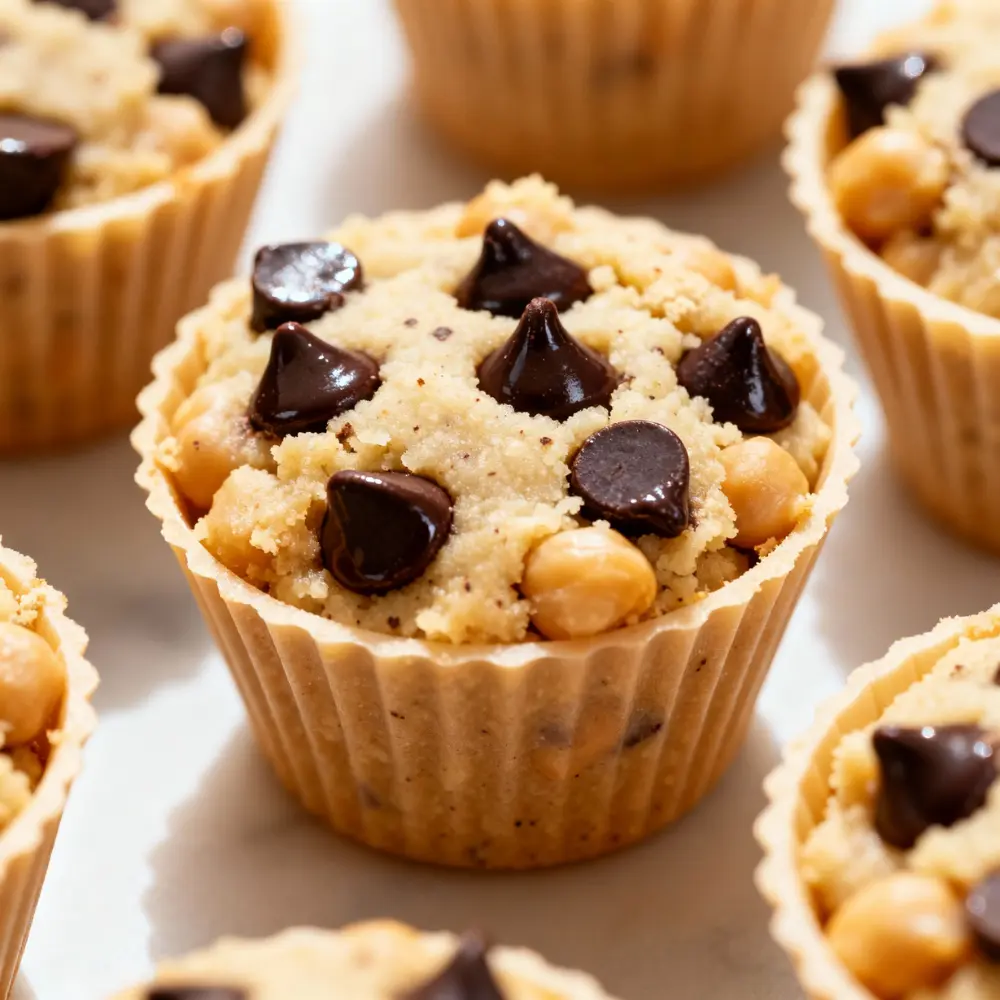
Macros per cup
Approx 210 kcal, 10 g protein, 24 g carbs, 8 g fat
Makes 8 cups
Ingredients
- 1 can chickpeas, drained and rinsed well
- 3 tbsp peanut butter
- 3 tbsp maple syrup or 2 tbsp coconut sugar
- 1 tsp vanilla extract
- Pinch of salt
- 1⁄2 cup quick oats
- 2 tbsp mini dark chocolate pieces
Directions
- Blend chickpeas, peanut butter, sweetener, vanilla, and salt until smooth.
- Pulse in oats until the mix holds together.
- Fold in chocolate pieces.
- Press into small silicone cups. Chill 30 to 60 minutes.
Substitutions
- Swap peanut butter for almond butter.
- Add 1 tbsp cocoa for a chocolate base.
- For extra protein, fold in 2 tbsp fine milk powder or 2 tbsp cottage cheese if dairy is acceptable.
Storage
Refrigerate up to 5 days. Freeze up to 1 month.
These options expand high protein desserts with global and gluten and dairy free ideas. They keep high protein recipes practical and unique, adding real value through simple methods, clear portions, and easy swaps.
Frequently Asked Questions (FAQs)
When should I eat a protein dessert for best results
Enjoy one after workouts to support recovery, as a mid morning or afternoon snack to curb cravings, or as an evening treat that satisfies without a sugar crash. Keep portions sensible and aligned with your goals.
What protein sources work best for sweet recipes
For smooth results, whey blends easily. Plant options like pea and soy work well with a little extra liquid and flavor boosters like cocoa or vanilla. Whole food choices such as Greek yogurt, cottage cheese, tofu, skyr, and ricotta give reliable protein with a pleasant taste.
Can I make high protein desserts without protein powder
Yes. Build high protein recipes with whole food bases like Greek yogurt, cottage cheese, silken tofu, chickpeas, black beans, nuts, and seeds. These keep flavors clean and textures creamy.
Are high protein desserts good for weight loss
They can help when portions stay reasonable and added sugars are kept low. Protein increases fullness and supports muscle maintenance, so high protein desserts make it easier to manage overall calories.
Author, Reviewer, and Sources
About the author

Chef Brooke is a 40 year old chef at ZurbanRecipe. He develops and tests every dessert end to end, tasting for flavor and texture, simplifying steps, and providing clear macros per serving. The aim is to make protein focused desserts feel indulgent and practical for home cooks.

